Although the National Park Service manages only a fraction of the total area needed for effective conservation of pinnipeds, it manages some of their key habitats, which affords them extra protection for reproduction and survival.
Abstract
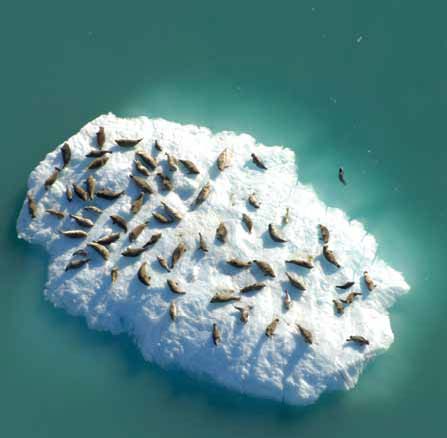
NPS/Jamie N. Womble
The evolutionary record from previous climate perturbations indicates that marine mammals are highly vulnerable but also remarkably adaptable to climatic change in coastal ecosystems. Consequently, national parks in the Pacific, from Alaska to Hawaii, are faced with potentially dramatic changes in their marine mammal fauna, especially pinnipeds (seals and sea lions). Impacts of climate change on pinnipeds may be manifest in changes in sea temperature, sea level, incidence of storm surge, ocean acidification, loss of glacial ice, and alterations in oceanic processes such as the frequency of El Niño events. These potential changes portend challenges to park management in responding to loss of habitat, mass strandings of sick or dead pinnipeds, alterations in prey availability, or range shifts with species expanding into or contracting out of national parks. The National Park Service could benefit from a regional approach to guide parks with a suite of actions to help conserve pinniped populations in response to climate change: (1) increased information and modeling to forecast pinniped habitat at risk, (2) increased protection via designation of marine protected areas, (3) restoration of degraded habitat, and (4) communication with the public. Since parks are islands in a larger seascape, coordination with other agencies and groups that also manage for pinniped conservation is essential.
Introduction
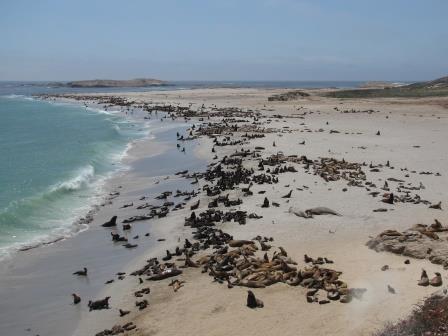
Courtesy Tony Orr, NOAA
Climate change will likely have a profound impact on resources in Pacific Ocean national parks. Changes are predicted to occur in sea- level rise, food webs, community structure of marine organisms, and oceanographic processes. Nevertheless, predicting the nature or extent of these changes and their impacts is highly uncertain (Stephenson et al. 2010). For example, sea temperature, salinity, and ocean circulation are expected to change, but because they are interrelated and vary spatially and seasonally, scientists expect “unexpected” responses by organisms (NRC 2002). Most scientists, though, agree that ocean and coastal conditions, including those in Pacific Ocean parks, will be altered over the coming decades as a result of climate change(Largier et al. 2011; Learmonth et al. 2006). Ocean parks of the National Park System have common oceanographic and biological settings and related vulnerabilities to changes in climate, and staffs are seeking ways to coordinate response strategies. Here we consider the potential impacts of climate change on pinnipeds (seals and sea lions) that occur in some 18 national parks around the Pacific Ocean from Hawaii to Alaska, and the role that the National Park Service can play in conserving this group of marine mammals.
Pinnipeds occur throughout the Pacific Ocean and range from critically endangered monk seals (Monachus schauinslandi) that use select sites in several Hawaiian Island parks to the more cosmopolitan harbor seals (Phoca vitulina) that use a diversity of habitats in parks from Alaska to California (table 1; figs. 1 and 2). This group of marine mammals faces unusual challenges because they rest and pup (“haul out”) on land and ice but forage at sea, sometimes in close proximity to haul-outs, but often traveling great distances to feed. Although the National Park Service manages only a fraction of the total area needed for effective conservation of these species, it manages some key habitats for pinnipeds, which affords them extra protection for reproduction and survival. To this end, a specific management strategy for pinnipeds within parks in collaboration with other management agencies is needed. We first describe linkages between climate change and pinniped abundance and distribution in national parks, and then highlight four specific roles that parks can play that will aid in conserving these animals and their habitats.
| Common Name | Scientific Name | Parks | Breeding |
| Monk seal | Monachus schauinslandi |
Hawaii Volcanoes NP** | |
| Kalaupapa NHP | X | ||
| Kaloko-Honoköhau NHP | |||
| Pu‘uhonua o Hōnaunau NHP | |||
| Northern elephant seal | Mirounga angustirostris | Point Reyes NS | X |
| Golden Gate NRA | |||
| Channel Islands NP | X | ||
| Harbor seal | Phoca vitulina | Aniakchak NM&P | X |
| Glacier Bay NP&P | X | ||
| Katmai NP&P | X | ||
| Kenai Fjords NP | X | ||
| Klondike Goldrush NHP | |||
| Lake Clark NP&P | X | ||
| Wrangell-St.Elias NP&P | X | ||
| Olympic NP | X | ||
| Lewis and Clark NHP | |||
| Redwood NP | X | ||
| Point Reyes NS | X | ||
| Golden Gate NRA | X | ||
| Channel Islands NP | X | ||
| Cabrillo NM | |||
| Steller sea lion | Eumetopias jubatus | Aniakchak NM&P | |
| Glacier Bay NP&P | X | ||
| Katmai NP&P | |||
| Kenai Fjords NP | X | ||
| Klondike Goldrush NHP | |||
| Lake Clark NP&P | |||
| Wrangell-St. Elias NP&P | |||
| Olympic NP | X | ||
| Redwood NP | |||
| Point Reyes NS*** | |||
| Channel Islands NP*** | |||
| California sea lion | Zalophus californianus | Glacier Bay NP&P | |
| Olympic NP | |||
| Lewis and Clark NHP | |||
| Redwood NP | |||
| Point Reyes NS | |||
| Golden Gate NRA | |||
| Santa Monica Mountains NRA | |||
| Channel Islands NP | X | ||
| Northern fur seal | Callorhinus ursinus | Channel Islands NP | X |
| Guadalupe fur seal | Arctocephalus townsendi | Channel Islands NP | X |
*Parks in the Pacific Ocean where pinnipeds do not occur or sightings are accidental include National Park of American Samoa, War in the Pacific NHP, USS Arizona Memorial, Haleakalä NP, and Pu’ukoholä Heiau NHS.**NHP= national historical park, NM=national monumnet, NP=national park, NP&P=national park and preserve, NRA=national recreation area, NS=national seashore.***Sea lions occurred here and gave birth within the past 40 years.
Climate change effects on pinnipeds
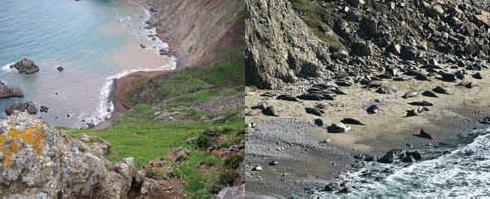
NPS
Pinnipeds are unique marine mammals because they spend much of their life at sea but require land or ice to give birth. Consequently, climate change may affect their distribution and abundance through direct pathways, such as loss or gain of terrestrial and ice habitat needed for resting and birthing, or indirect pathways, such as changes in prey availability or incidence of disease via altered ocean conditions (Learmonth et al. 2006). Projected changes on pinniped distribution may have both positive and negative effects, a glimmer of which is now noticeable (Simmonds and Isaac 2007).
Recent research demonstrates how climate change is already influencing habitat availability for pinnipeds in Pacific Ocean parks. The Muir Glacier, for example, an actively calving glacier in Glacier Bay National Park, Alaska, has receded from saltwater and “grounded” in the past few decades (Hall et al. 1995). Prior to this grounding, investigators counted more than 1,300 seals in upper Muir Inlet (Streveler 1979), but because of loss of icebergs, that number is now zero (Mathews 1995; Womble et al. 2010). Although the relationship between calving glaciers and climate is complex (Post et al. 2011), ice sheets that feed glaciers in Glacier Bay have undergone rapid loss of ice and retreat over the last 200 years (Hall et al. 1995; Larsen et al. 2007) . If loss of ice-associated habitat continues as predicted (Larsen et al. 2007), seals in Glacier Bay, which still use ice calved from the Johns Hopkins Glacier, will be forced to use terrestrial substrate for breeding or move out of the park to find glacial ice in other areas.
Factors such as increased exposure to land-based predators and reduced breeding success, as has been demonstrated for other pinnipeds (e.g., Jüssi et al. 2008), may result if available ice is reduced. Changes in seal numbers and distribution within the park may not necessarily affect the overall regional population of seals. For the least adaptable pinnipeds such as ice-dependent species, scientists expect negative effects from changes in climate; on the other hand, climate change could affect pinnipeds positively if it opens suitable habitat for species with expanding ranges (Harington 2008; Simmonds and Isaac 2007). Similarly, inundation of low-lying areas might provide access to previously inaccessible inshore areas or nearshore islands.
Changes in ocean conditions also have affected the suitability of some substrates for pinnipeds in Channel Islands National Park and Point Reyes National Seashore. Sea-level rise of 20 cm (8 in) over the past century in California (Largier et al. 2011), coupled with storm surge, has altered some habitats by inundating low-lying areas and eroding shorelines used by pinnipeds (figs. 3 and 4). Similar exposure to sea-level rise is expected for monk seals in the Hawaiian Islands (Baker et al. 2006).
El Niño events in the Pacific offer a glimpse at the complex effects of globally warmer sea temperatures on pinnipeds and presage likely scenarios for these animals. During past El Niño events in 1982 and 1998, pinniped productivity and survival declined significantly at Channel Islands and Point Reyes because of reduced prey availability or storm-driven tidal inundation, which drowned pups (Trillmich and Ono 1991; Sydeman and Allen 1999) (see fig. 4). With ocean warming, El Niño events are projected to increase in frequency and intensity (Trenberth and Hurrell 1994; Bakun 1990). Additionally, harmful algal blooms during the 1998 El Niño event resulted in spikes in the number of sick and dead sea lions that became stranded on park beaches in California (Gulland et al. 2002). Such harmful algal blooms, likely linked to climate change and warmer sea temperatures, have increased over the past three decades (Van Dolah 2000).
Conservation strategies
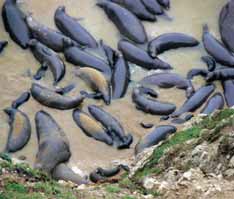
NPS
The evolutionary record from previous climate perturbations indicates that marine mammals are both highly vulnerable and remarkably adaptable to changes in coastal ecosystems (e.g., Harington 2008). Generalist and cosmopolitan species such as harbor seals are greatly adaptable and may simply move elsewhere or use newly formed habitat when other areas become degraded. In contrast, obligate species such as ice breeders, or those with reduced numbers, including endangered species, may be less resilient to changes in the environment. Whether managing for pinniped generalists or obligates, park staffs will be challenged to preserve and protect species and their habitats in a rapidly changing climate.
In concert with conservation strategies of other agencies and organizations, we propose four key strategies for the National Park Service that will assist in assessing the magnitude of climate change impacts on pinnipeds and contribute to their conservation both in parks and across their range: (1) adaptively monitor pinniped populations and linkages to environmental conditions; (2) reduce anthropogenic stressors such as physical disturbance and fisheries interactions; (3) restore pinniped habitats; and (4) communicate with and engage the public about these strategies.
First, the National Park Service needs to expand its efforts to collect data on population dynamics, pup production, disease status, and habitat condition of pinnipeds in the National Park System (Burek et al. 2008). This would contribute to better estimates of species abundance and also better forecasting of impacts from climate scenario modeling. A long history of monitoring pinniped population trends by other agencies and by the National Park Service in several national parks (Brown et al. 2011; Womble et al. 2010; Sydeman and Allen 1999) already provides critical baseline information for interpreting the influence of climate change on these species. Most coastal parks, though, lack pinniped studies that link population data with current and future environmental conditions. Glacier Bay National Park recently partnered with the National Marine Mammal Laboratory to develop and implement an aerial photography monitoring program that records not just the abundance and spatial distribution of seals but also ice conditions and substrate availability for pupping. Similar studies that link pinnipeds with environmental conditions, including changes in oceanography and shoreline, could be augmented or initiated at other parks.
Second, establishment of marine protected areas (MPAs) and special area closures for pinnipeds are management options that can reduce tangential threats, such as direct interactions with humans and disturbance from coastal development and fisheries, and have been successfully implemented in a few ocean parks. For example, in Johns Hopkins Inlet in Glacier Bay National Park, the National Park Service restricted all vessel traffic during the pupping season to protect harbor seals during this critical period. At Point Reyes, kayaks were similarly prohibited in Drakes Estero during the harbor seal pupping season. The Park Service can also work to evaluate the benefits to pinnipeds of reducing or eliminating commercial fishing in or adjacent to national parks. Commercial fishing can result in localized depletion of pinniped prey, even if the fisheries are sustainable at a larger scale (NRC 2006; Womble et al. 2009).
Unfortunately, indirect benefits of marine protected areas to pinnipeds, such as prey availability, are difficult to measure and relationships are complicated. For example, monk seals appear to suffer from competition with large predatory fish in a marine reserve in the northwestern Hawaiian Islands whereas they benefit from commercial extraction of large fish in the main Hawaiian Islands (Parrish et al. 2008). This seal species has also benefited from restricted access to specific breeding sites such, as Kalaupapa National Historical Park (Brown et al. 2011). Similarly, at Golden Gate National Recreation Area, California, the rate of disturbance has decreased as seal numbers have increased where human traffic was restricted in 2007 at a harbor seal colony (Flynn et al. 2009). Clearly, research on the effects of marine protected areas in specifically conserving pinnipeds needs close scrutiny and further study on a case-by-case basis.
The creation of a global network of marine protected areas may be more broadly effective in the protection of mobile marine mammals (Hoyt 2011), and one study showed that setting aside a small fraction of the oceans could result in conservation of more than 80% of the world’s marine mammals (Pompa et al. 2011). The National Park Service has been engaged in establishing networks of marine protected areas with other agencies so that national parks can serve as refuges in the larger seascape. One such example is the International Committee for Marine Mammal Protected Areas, an international body working toward creating, maintaining, and understanding the effectiveness of protected areas for marine mammals. The State of California, in collaboration with Channel Islands National Park and Point Reyes National Seashore, has established networks of MPAs coincident with pinniped colonies. A network of protected areas that involves national parks around the Pacific Rim could enhance the resilience and perpetuation of ecologically intact coastal ecosystems. Although national parks manage only a fraction of the total range of any given pinniped species, these spatially dispersed refuges enhance a fundamental MPA goal: to preserve ecological integrity. Similarly they are consistent with pinniped conservation given that these marine mammals, as apex predators, are often indicators of healthy marine ecosystems (NOAA 2008).
Third, the National Park Service can actively restore degraded habitats. Restoration of coastal habitats and removal of nonnative species enhance suitable places for pinnipeds to congregate onshore, and surprisingly, there are a number of areas in national parks that would benefit from active restoration. At Kalaupapa National Historical Park, for example, the removal of cattle, coupled with fencing of beaches to restrict feral ungulates, has coincided with the emergence of a productive pupping area for monk seals (Brown et al. 2011; fig 5). Large-scale restoration projects such as the Elwha Dam removal at Olympic National Park, Washington, will extend benefits to regional coastal ecosystems and species, including seals and sea lions. Pinnipeds attracted to restored park habitats would further benefit from the added protection afforded by the National Park System.
Finally, key to any adaptive management approach is to ensure that risks, strategies, and potential outcomes are explored and developed with involvement of interested communities and other management groups and then communicated with the public. In Pacific Ocean parks, a group of interpreters (Pacific Ocean Education Team, POET) was organized in 2008 to identify issues important for ocean stewardship and to serve as a voice for park managers to advance strategies for conservation of marine mammals. Pinnipeds specifically, and marine mammals in general, are a highly sought-after viewing experience for visitors to Pacific Ocean parks, and the connection they make with marine mammals is an effective opportunity to convey facts regarding climate change impacts on national park resources. Communicating this message and coordinating actions with other organizations will ensure a consistent message for public understanding.
Conclusion
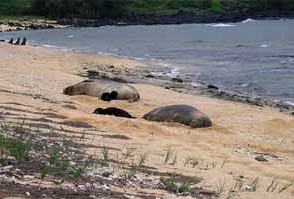
NPS/Eric Brown
Historically, national parks were managed in isolation with the idea that local anthropogenic influences on their resources could be tempered. However, climate change, pollution from distant sources, large-scale changes in land use patterns, and other environmental factors have altered this perception, and recent publications have highlighted the need not just to accept that change is forthcoming but also to develop proactive coping strategies (Aplet and Cole 2010). We hope to build on these strategies for conserving pinnipeds in Pacific Ocean parks, recognizing that the National Park Service plays an important role in the conservation of these marine mammals and their coastal habitats with a changing climate.
References
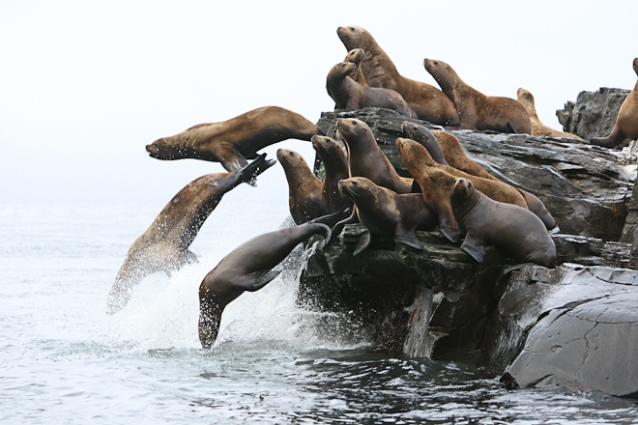
Courtesy Vladimir Burkanov, NOAA
Aplet, G.H., and D.N. Cole. 2010. The trouble with naturalness: Rethinking park and wilderness goals. Pages 12-29 in D.N. Cole and L. Yung, editors. Beyond naturalness. Rethinking park and wilderness stewardship in an era of rapid change. Island Press, Washington, D.C., USA.
Baker, J. D., C. L. Littnan, and D. W. Johnston. 2006. Potential effects of sea level rise on the terrestrial habitats of endangered and endemic megafauna in the northwestern Hawaiian Islands. Endangered Species Research 4:1–10.
Bakun, A. 1990. Global climate change and intensification of coastal ocean upwelling. Science 247:198–201.
Brown, E., G. Hughes, R. Watanuki, T. Johanos, and T. Wurth. 2011. The emergence of an important Hawaiian monk seal (Monachus schauinslandi) pupping area at Kalaupapa, Molokai, in the main Hawaiian Islands. Aquatic Mammals 37:319–325.
Burek, K. A., F. M. D. Gulland, and T. O. O’Hara. 2008. Effects of climate change on Arctic marine mammal health. Ecological Applications 18:S126–S134.
Flynn, E., D. Press, S. Codde, D. Roberts, and S. Allen. 2009. Pacific harbor seal (Phoca vitulina richardii) monitoring at Point Reyes National Seashore and Golden Gate National Recreation Area: 2010 annual report. Natural Resource Technical Report NPS/SFAN/NRTR-2011/465. National Park Service, Fort Collins, Colorado, USA.
Gulland, F. M. D., M. Haulena, D. Fauquier, G. Langlois, M. Lander, and T. Zabka. 2002. Domoic acid toxicity in California sea lions (Zalophus californianus): Clinical signs, treatment and survival. Veterinary Record 150:475–480.
Hall, D. K., C. S. Benson, and W. O. Field. 1995. Changes of Glaciers in Glacier Bay, Alaska, using ground and satellite measurements. Physical Geography 16:27–41.
Harington, C. R. 2008. The evolution of Arctic marine mammals. Ecological Applications 18 (Supplement):S23–S40.
Hoyt, E. 2011. Marine protected areas for whales, dolphins and porpoises. Second edition. Earthscan, London, UK.
Jüssi, M., T. Härkönen, E. Helle, and I. Jüssi. 2008. Decreasing ice coverage will reduce the breeding success of Baltic grey seal (Halichoerus grypus) females. Ambio 37:80–85.
Largier, J., B. Cheng, and K. Higgason, editors. 2011. Climate change impacts: Gulf of the Farallones and Cordell Bank National Marine Sanctuaries. Marine Sanctuaries Conservation Series ONMS-11-04. National Oceanic and Atmospheric Administration, Office of National Marine Sanctuaries, Silver Spring, Maryland.
Larsen, C. F., R. J. Motyka, A. A. Arendt, K. A. Echelmeyer, and P. E. Geissler. 2007. Glacier changes in southeast Alaska and northwest British Columbia and contribution to sea level rise. Journal of Geophysical Research 112, F01007:1–11.
Learmonth, J. A., C. D. Macleod, M. B. Santos, G. J. Pierce, H. Q. P. Crick, and R. A. Robinson. 2006. Potential effects of climate change on marine mammals. Oceanography and Marine Biology: An Annual Review 44:431–464.
Mathews, E. A. 1995. Long-term trends in the abundance of harbor seals (Phoca vitulina richardii) and development of monitoring methods in Glacier Bay National Park, Southeast Alaska. Pages 254–263 in D. R. Engstrom, editor. Proceedings of the Third Glacier Bay Science Symposium, U.S. National Park Service, Glacier Bay National Park and Preserve, Gustavus, Alaska, USA.
Mathews, E. A., and G. W. Pendleton. 2006. Declines in harbor seal (Phoca vitulina) numbers in Glacier Bay National Park, Alaska, 1992–2002. Marine Mammal Science 22(1):167–189.
NOAA (National Oceanic and Atmospheric Administration). 2008. Framework for the national system of marine protected areas of the United States of America. Final report. Available at www.mpa.gov/pdf/ nation-system/finalframework_full.pdf.
NRC (National Research Council). 2002. Abrupt climate change: Inevitable surprises. National Academies Press, Washington, D.C., USA.
NRC. 2006. Decline of the Steller sea lion in Alaskan waters—Untangling food webs and fishing nets. National Academies Press, Washington, D.C., USA.
Parrish F. A., G. J. Marshall, B. Buhleier, and G. A. Antonelis. 2008. Foraging interaction between monk seals and large predatory fish in the northwestern Hawaiian Islands. Endangered Species Research 4:299–308.
Pompa, S., P. R. Ehrlich, and G. Ceballos. 2011. Global distribution and conservation of marine mammals. Proceedings of the National Academy of Sciences 108(30):13600.
Post, A., S. O’Neel, R. J. Motyka, and G. Streveler. 2011. A complex relationship between calving glaciers and climate. EOS 92(37):305. doi:10.1029/2011EO370001.
Simmonds, M., and S. Isaac. 2007. The impacts of climate change on marine mammals: Early signs of significant problems. Oryx 41:1–8.
Stephenson, N. L., C. I. Millar, and D. N. Cole. 2010. Shifting environmental foundations: The unprecedented and unpredictable future. Pages 50–66 in D. N. Cole and L. Yung, editors. Beyond naturalness: Rethinking park and wilderness stewardship in an era of rapid change. Island Press, Washington, D.C., USA.
Streveler, G. 1979. Distribution, population ecology, and impact susceptibility of the harbor seal in Glacier Bay, Alaska. Unpublished report. National Park Service, Glacier Bay National Park and Preserve, Alaska, USA.
Sydeman, W.J. and S.G. Allen. 1999. Pinniped population dynamics in central California: Corrrelations with sea surface temperature and upwelling indices. Marine Mammal Science 15:446-461.
Trenberth, K. E., and J. W. Hurrell. 1994. Decadal atmosphere-ocean variations in the Pacific. Climate Dynamics 9:303–319.
Trillmich, F., and K. Ono. 1991. Pinnipeds and El Niño: Responses to environmental stress. Ecological Studies 88. Springer-Verlag, Berlin, Germany.
Van Dolah, F. 2000. Marine algal toxins: Origins, health effects, and their increased occurrence. Environmental Health Perspectives 108:133–141.
Womble, J. N., G. W. Pendleton, E. A. Mathews, G. M. Blundell, N. M. Bool, and S. M. Gende. 2010. Harbor seal declines continue in the rapidly changing landscape of Glacier Bay National Park, Alaska, 1992–2008. Marine Mammal Science 26:686–697.
Womble, J. N., M. F. Sigler, and M. F. Willson. 2009. Linking seasonal distribution patterns with prey availability in a central-place forager, the Steller sea lion. Journal of Biogeography 36:439–451.
About the authors
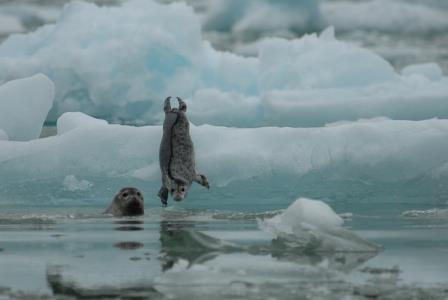
Courtesy Dave Withrow, NOAA
Sarah Allen is program lead for the Coast and Oceans Program of the National Park Service, Pacific West Region. Eric Brown is the marine ecologist at Kalaupapa National Historical Park. Kate Faulkner is chief of Natural Resources Management at Channel Islands National Park. Scott Gende is a senior science advisor for the National Park Service based in Alaska. Jamie Womble is a wildlife biologist with the National Park Service in Alaska.
Erin Kunisch with the Ocean Alaska Science and Learning Center prepared this article for the web. This article was originally published in Park Science (Volume 28, Number 2, Summer 2011).
Tags
- aniakchak national monument & preserve
- cabrillo national monument
- channel islands national park
- glacier bay national park & preserve
- golden gate national recreation area
- hawaiʻi volcanoes national park
- kalaupapa national historical park
- kaloko-honokōhau national historical park
- katmai national park & preserve
- kenai fjords national park
- klondike gold rush national historical park
- lake clark national park & preserve
- lewis and clark national historical park
- olympic national park
- point reyes national seashore
- puʻuhonua o hōnaunau national historical park
- redwood national and state parks
- santa monica mountains national recreation area
- wrangell - st elias national park & preserve
- adaptive management
- climate change
- el nino
- habitat loss
- marine protected areas
- pinniped
- sea-level rise
- sea lions
- seals
- pacific ocean
- ocean alaska science and learning center
- oaslc
- glba
- glacier bay research highlights
- science
- resource brief
- marine animals and birds
- blog
Last updated: October 16, 2020
